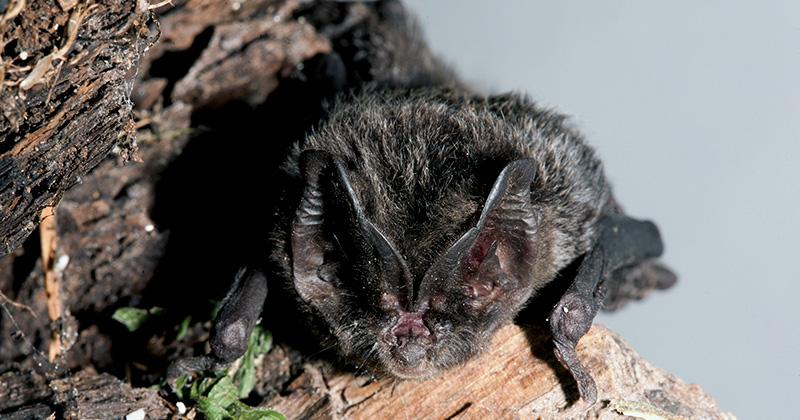
What Are Their Characteristics?
The UK barbastelle population is estimated at just a mere 5,000 individuals. In fact, this species of bat is considered so under threat, it’s been identified as requiring national conservation under the UK Biodiversity Action Plan (UK BAP).
Barbastelles are a medium-sized bat with distinctive flat faces and pug-shaped noses. They have small eyes and broad, ridged ears that join in the middle of their forehead. This bat also grows white hairs on its lower lip - its scientific name Barbastella can be translated as ‘star beard!’
Bats of this species weigh in at 6g-13 (the new pound coin only weighs 8.75g) and they have a wingspan of 260mm-290mm (similar to the length of a sheet of A4 paper). When hunting prey, their echolocation call is around 32 kHz which sounds like short, hard smacks on a heterodyne bat detector. You can download and listen to it here.
During autumn, bats will build body fat ready for the coming winter. Females typically delay pregnancy until May, when they’ll head for nursery roosts with 10-20 others. Male bats, however, are off elsewhere in their own roosts, and play no part in caring for the young. If you’re looking to spot a baby barbastelle, keep your eyes peeled during late June – early July.
Where Can They Be Found?
Research suggests that UK breeding sites are limited to southern and central England and Wales.
Barbastelles prefer to keep incognito, leaving their roosts at dusk or when they can stay in dark shadows and spaces between trees. They forage over wide areas or open spaces, swooping down to drink from ponds and lakes. They’ve been known to travel over 13 miles (22 km) from their roost but, typically, they’ll stick to around 5 miles (7-8 km).
This species can usually be found in unmanaged woodland, with plenty of dead and mature trees. However, they are especially sensitive to disturbance and change their roosting sites frequently. Despite their natural roosts being difficult to locate, barbastelles can also be found in cavities of timber-framed buildings, hollow tree trunks and under loose bark.
In winter, they hibernate in trees, buildings, and sometimes even in cellars or caves. As the temperature rises in March, they become more active until they are foraging every summer evening (unless the temperature drops or it’s too wet).
What Does Their Diet Consist Of?
Barbastelles specialise in eating ‘eared’ moths, but it’s no easy task as many moth species have evolved ears to hear their bat predators and evade capture.
Not one to be outsmarted, barbastelles have evolved a counter-strategy of using quiet, ‘stealthy’ echolocation calls that the moths can’t easily detect. This allows the barbastelle to exploit a food that louder bats find difficult to catch. For now, at least, the barbastelle is winning the evolutionary arms race!
How Can We Help Protect Them?
Despite the best efforts of ecologists and wildlife enthusiasts alike, bat populations are declining - extensive loss of woodland habitats is a major factor.
If you have trees (or hedges) in your garden, you can:
- attract bats by installing a bat box
- grow plants that attract insects for the bats to eat
- limit artificial light (barbastelles generally stay away from outdoor lighting)
Barbastelle bats are strictly protected. If you think you may be living close to a barbastelle habitat it’s best to approach The Bat Conservation Trust for guidance.
Want to help protect the barbastelle? We stock a wide range of equipment for bats and school ecology which we’ll ship out to you with the fastest possible delivery. If you’d like to know more about any of our products, please don’t hesitate to contact us.
Data sources:
http://www.bats.org.uk/pages/barbastelle-1.html
http://www.arkive.org/barbastelle-bat/barbastella-barbastellus/
www.bats.org.uk/publications_download.php/747/barbastelle.pdf


